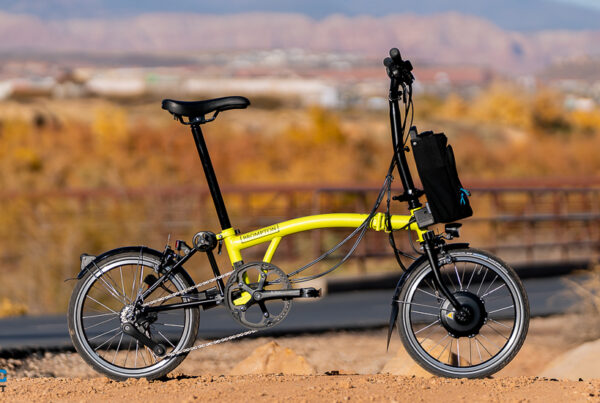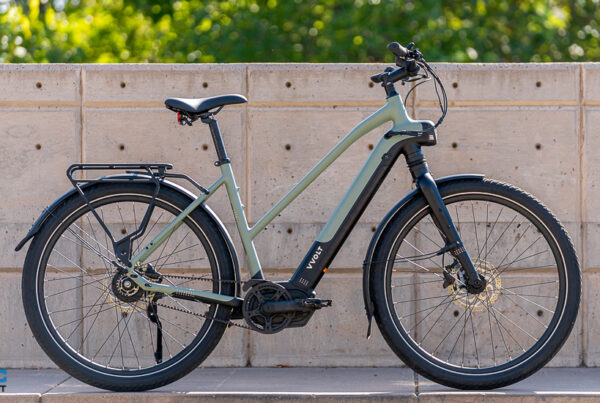Some links may be affiliate links. We may get paid if you buy something or take an action after clicking one of these.
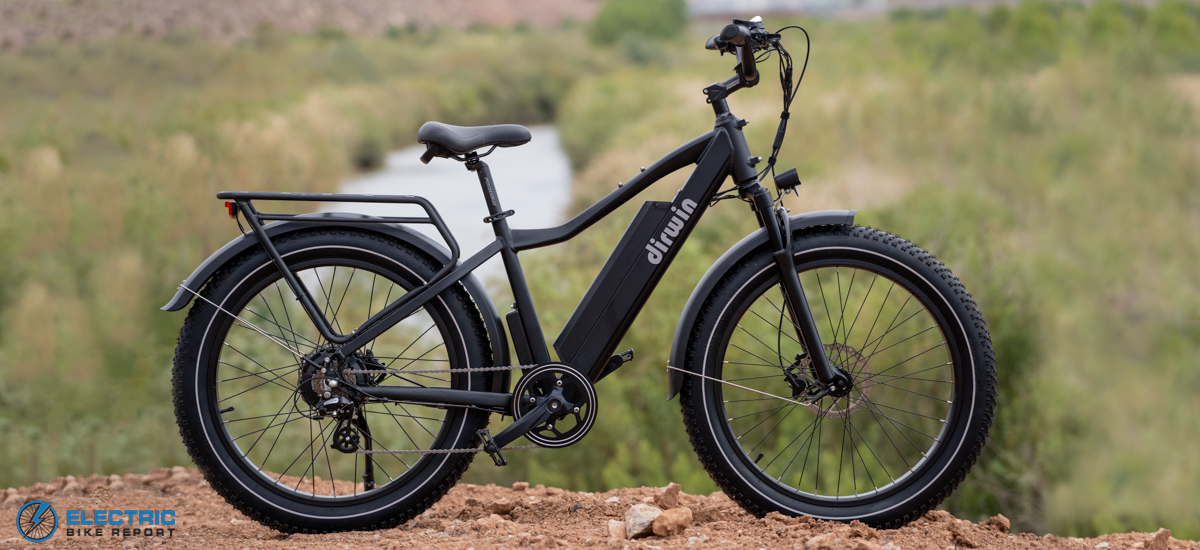
Dirwin Seeker Review: Overview
The Dirwin Seeker is a Class 3 electric fat bike that combines a powerful motor with a long battery life, intuitive display and comfortable ride geometry. When we reviewed the Dirwin Seeker we quickly learned how well rounded it is compared to some other e-bikes we’ve reviewed. From hill climbs, to off-road to general handling the Seeker impressed us with its wide array of strong suits.
The Seeker’s 750W motor produces up to 80Nm of torque. This makes for a very capable all-terrain bike that doesn’t have any issue plowing through sandy pits or up gravel roads. While plenty of fat tire e-bikes claim to have all terrain capability, very few prove it like the Seeker.
If you’re looking for a fairly priced Class 3 e-bike that won’t be confined to one terrain or style of riding, the Seeker may be the bike for you. With 4-inch wide tires, front suspension and plenty of power it’s ready for any adventure any time.
*Dirwin is including a coupon code for Electric Bike Report’s audience. You can receive $60 off the Dirwin Seeker when you click the button below use the code JUSTIN at checkout.
***The Dirwin’s throttle and pedal assistance max speed are tied and must be adjusted together, so unless you disconnect the throttle it can only legally be a Class 2 e-bike. Keep your area’s e-bike laws and regulations in mind.***
Bike Category: Fat Tire / Hybrid Path e-bike
Bike Class: Class 2/3PAS up to 25 mph / Throttle assist, up to 20 mph***
Dirwin Seeker Video Review
 Pro’s
Pro’s- The Seeker thrives on steep hill climbs thanks to its torquey 80Nm motor.
- The Seeker comes with a very visually-appealing display that has a unique interface.
- The 16Ah battery lasts for long periods of time in the higher assistance levels.
- The Seeker’s motor engagement is smoother than what we are used to on most fat tire e-bikes with rear hub motors.
- We always appreciate seeing hydraulic brakes on a large/fast bike like the Seeker.
- The Seeker had one of the most linear power curves we’ve seen from PAS levels.
- The Seeker has one of the higher max rider weights we’ve seen at 350 lbs
 Con’s
Con’s- Throttle is programmed past Class 2 regulations out of the box. You must adjust the bike’s max speed for it to be street legal in most areas.
- The hydraulic brakes and larger-than-most battery are a welcome sight on this bike, but it does make it a little pricier than its competitors.
- Like virtually all fat tire bikes, it’s heavy. So if you plan on transporting it on a rack take weight into consideration.
ELECTRICAL SPECS & FEATURES
- Battery: 48V, 16Ah lithium-ion
- Display: 3.5” TFT color display
- Motor: 750W hub motor
- Headlight: 48V headlight
- Taillights: 48V taillight
- Peal Assist: Levels 1-5
- Range: 25-50 miles
- Throttle: Half twist throttle
Weight & Dimensions
- Battery weight: 11 lbs
- Claimed weight: 74.9 lbs
- Real weight: 74.9 lbs
- Maximum rider weight: 350 lbs
- Maximum load on rear rack: 50 lbs
- Dimensions: 74.8” x 26.7” x 45.5” (length x width x height)
Components & Accessories
- Brakes: Logan hydraulic disc brakes, 180mm rotors
- Fenderss: Front and rear
- Fork: Spring suspension fork
- Frame: 6061 alloy
- Gearing: 7-speed Shimano Altus
- Grips: Ergonomic comfort grips
- Saddle: Wide comfort saddle, handle included
- Handlebar: High rise alloy handlebar
- Kickstand: Included, standard
- Pedals: Wellgo alloy pedals
- Tires: 26” x 4.0”
Dirwin Seeker Performance Review
Acceleration / Speed
Since the throttle and pedal assist max speed are tied and cannot be adjusted independently, you’ve got to disconnect the throttle to legally ride the Seeker as a Class 3 e-bike. Or, you can adjust the bike’s overall top speed down to 20 mph to make it a Class 2 e-bike.
Out of the box, our Dirwin test bike was set with a max motor-assisted speed of 24 mph. Remember, with the throttle operational, the Seeker is not street legal in most areas at this speed. But with the throttle disconnected, we found the Dirwin’s 750W motor easily floated near that 24 mph max. Unlike many e-bikes capable of Class 3 speeds, the Seeker’s max speed can’t be adjusted up to the 28 mph Class 3 max — the highest it would go is 25 mph.
The motor has 80 Nm of torque, which I really noticed on steep hill climbs and when accelerating from a stand still where the motor’s acceleration felt quick but still predictable. While some other Class 3 fat tire bikes may go a little faster on flat ground, this bike goes just as fast on steep hill climbs.
The way the bike is able to pace itself makes it feel well put together. The motor never felt like it was’ redlining and it always had some power in the reserves for when things got tough. The Seeker comes with a 350 lb payload, speaking numbers to the strength and power of the motor and bike as a whole.
Range Test
The Dirwin Seeker comes with a 48V, 16Ah battery which is on the larger side of batteries that we’ve seen on the electric fat bikes we’ve tested this year. We conducted a range test to see how far the battery would get us on a single charge in maximum pedal assist, and minimum pedal assist. This gives our team a good idea of the true real-world battery range on the Dirwin Seeker.
When I rode in maximum pedal assist it took 32.41 miles for the battery to die. I rode at an average speed of 20.7 mph which was just 3.3 mph off of the bikes overall top speed. Despite the top speed being slightly lower than some other Class 3 e-bikes, my hill climb segment times were very similar to the faster bikes.
When our test rider rode the Seeker in the lowest pedal assist setting it took him 45.13 miles for the 16Ah battery to die. He rode at an average speed of 12.7 mph. The Seeker is tuned to still give a decent amount of assistance in the lowest pedal assist setting and because of that the minimum pedal assist range is a little shorter than some other bikes.
With the amount of assistance taken into consideration, 45-plus miles is actually a pretty solid result. It’s better to go 45 miles with some assistance than even further with virtually none at all.
Circuit test
The Dirwin Seeker comes with 5 total pedal assist levels. We ride around a 1-mile loop in each level to get a good idea of how each pedal assist setting performs . This also shows us how fast you can expect to go in each setting and how big of increments there are between each of them.
The Dirwin Seeker has one of the most linear power curves we’ve seen. I am a big fan of how this bike jumps from level to level; each time I increased the pedal assist level I knew exactly what to expect. Each jump will yield around a 2-3 mph increase in average speed.
In the highest pedal assist level, our test rider Griffin had an average speed of 21 mph around the loop which isn’t far off of the bike’s 24 mph top speed. Griffin’s a big guy so lighter riders may see even quicker times.
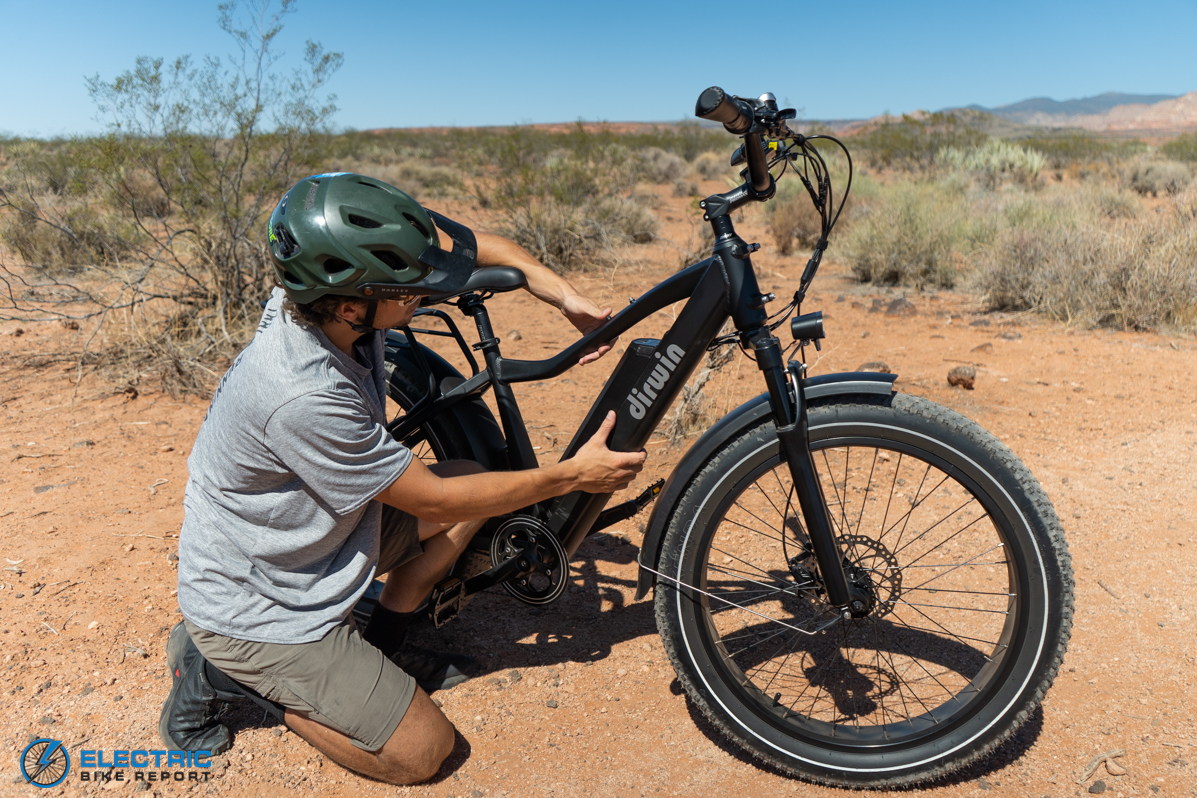
Removing the 48V, 16Ah battery from the Seeker.

The full cockpit on the Seeker.
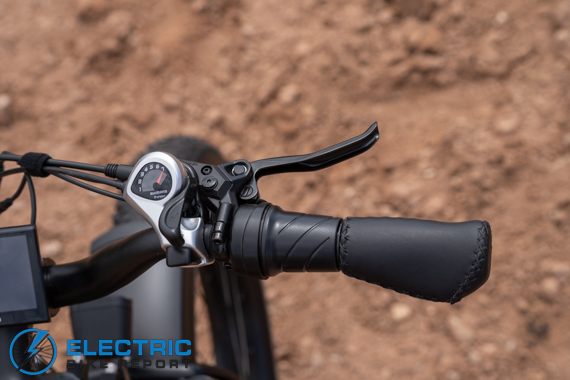
Twist grip throttle, brake lever and thumb shifter.
Hill Test
I was very impressed by the Seeker’s hill climbing ability. I really noticed the 80Nm of torque when conducting our hill test. I climbed our test hill twice, once with the throttle only and again in the highest pedal assist level.
Using throttle only, it only took me 1:19 to reach the top of our quarter-mile test hill, which has a 12%-15% grade. Considering the fact that I wasn’t helping the bike at all, this result is super impressive. I’ve tested bikes that are slower than that when I was using the highest pedal assist setting.
In PAS 5 (max assist) I reached the top of the test hill at a blazing 1:04. This is one of the faster times we’ve seen up our test hill. The way the Seeker was able to accelerate on the flatter parts of the hill allowed it to maintain momentum up the steeper parts. I knew this bike was powerful but it still surprised me with how easy it was for it to make it up our test hill.
Handling
The Dirwin Seeker hints at its all-terrain capabilities in the way it handles. The fat tires and suspension fork made the Seeker very stable on all the paved and unpaved surfaces I rode it on.
I found it’s also easier to corner this bike sharply than some other similar electric fat bikes I’ve tested. I think this is due to the longer than average stem that slows the steering a bit and makes this thing feel a little more stable. In simpler terms, it felt like it kept the front tire stuck to the ground.
I loved the way this bike felt on gravel roads, the tires dug into the gravel and the high-torque motor allowed me to maintain speed and traction.
Ride Comfort/Geometry
I found the Seeker to be a pretty comfortable e-bike. It rides very soft and smooth thanks to its large tires, suspension fork and comfort-oriented grips and saddle. A lot of the vibrations and chatter that cause fatigue are absorbed by the bike which makes for a more controlled and predictable ride.
The wide saddle distributed my weight very evenly and it was rare that I had to reposition myself. The shape of the grips were nice but I would like them to be made of a little tackier compound, when my hands got sweaty the grips were a little bit slick.
The ride positioning on the Seeker is upright but not as upright as a lot of other fat tire e-bikes. This positioning is a little more performance oriented and sporty which helped a lot on the climbs and off road stretches of trail.
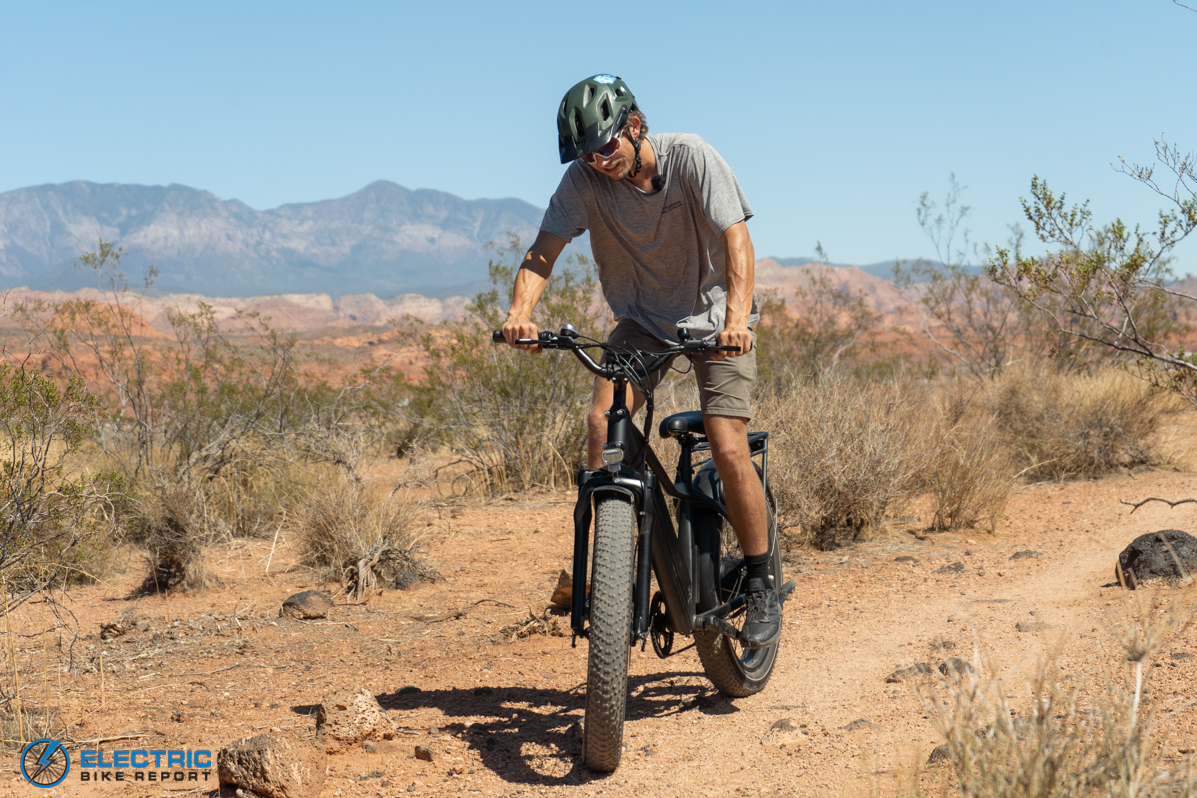
The Dirwin Seeker smoothing out the trail.
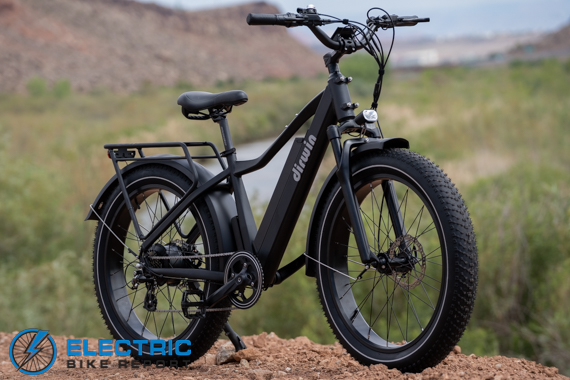
Overlooking the river.
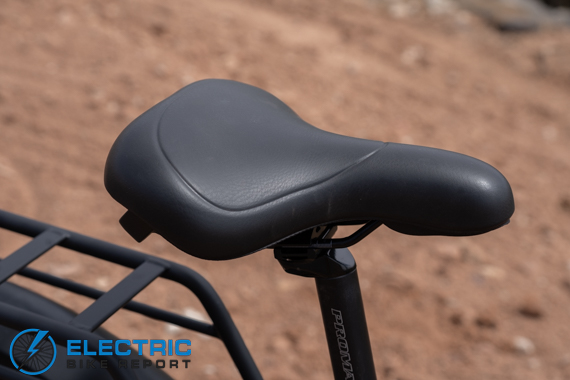
Comfort saddle with handle.
Dirwin Seeker Specs/Features Review: Electric Components
Motor
The 750W rear hub motor can produce up to 80 Nm of torque and engages very smoothly and predictably. The tuning of this motor feels very well done. It accelerates quickly, yet safely and always seems to have some extra power in the reserves for when things get tough.
I think Dirwin is onto something with limiting the Seeker to 24 mph in the Class 3 setting. Because of this, the 750W motor can save its power for when you truly need it as opposed to the motor burning itself out hovering at a high speed on a straight away.
The 80 Nm of torque plays a big factor in the Seeker’s off-road ability. It has enough torque to get through loose terrain like sand pits and gravel hills.
Battery
The Seeker’s semi-integrated 48V, 16Ah battery provided our team with a solid battery range. I was pleased to reach over 30 miles in the highest assistance level when I conducted the range test.
While we did not reach Dirwins claimed range of 35-60 miles on either our short or long range tests, I still feel like the battery held a respectably long charge for how much power the 750W motor consumes.
This battery is removable with the key that comes with the bike and takes 6-9 hours to reach a full charge. Between the performance, capacity and the sleek integration of the battery it checks all the boxes for what I’d look for in a battery for a bike of this price point.
Pedal Assist / Throttle
The Dirwin Seeker’s pedal assist levels feel very well calibrated. Each jump from level to level is predictable and consistent. When we conducted our circuit test we saw that the Seeker had one of the more linear power curves out of the bikes we’ve tested.
This is good to see for a couple of reasons: It gives each assist level a true purpose and it gives you a good idea of what to expect each time you increase or decrease the pedal assist setting.
The bike also has a “PAS 0” setting where the display and lights are turned on, but no assistance is received from the motor. This is a good safety feature for if you’re just pushing the bike or moving it around the garage, as it disengages the throttle as well. The bike turns on in PAS 1, so you’ll have to select PAS 0 if you choose to use it.
Our bike shipped with the throttle going 24, higher than the acceptable regulation. We toned it down to 20 mph or disengaged it all together during Class 3 testing. Even with the reduced top speed, the throttle shows the bikes power and speed as it accelerates rather quickly. It also has a good amount of power modulation where you can easily moderate how much power the throttle is feeding to the motor.
Display
The 3.5” color LCD display is great. The interface and broad spectrum of colors this display has puts it a step above your average display.
When you ride above 8 mph the display only shows your current speed, but when you drop below 8 mph the display shows more information, like your mileage and pedal assist level. I think this is a cool feature because the bike recognizes you’re slowing down, thus giving you more information to look at.
This display also gives you the ability to make some changes to the Seeker, whether it be the screen brightness or the bikes top speed it’s all programmable via the display.
Pro tip: when modifying the speed limit use the code “0510” as the passcode.
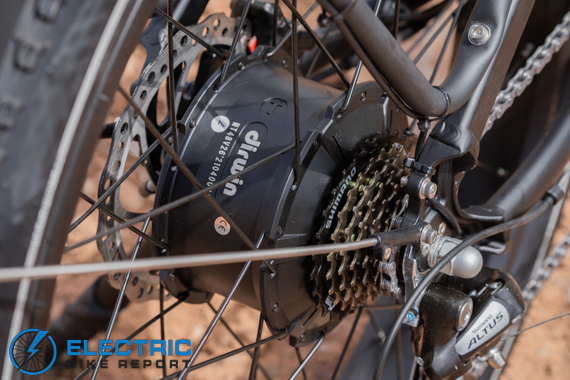
750W rear hub motor.
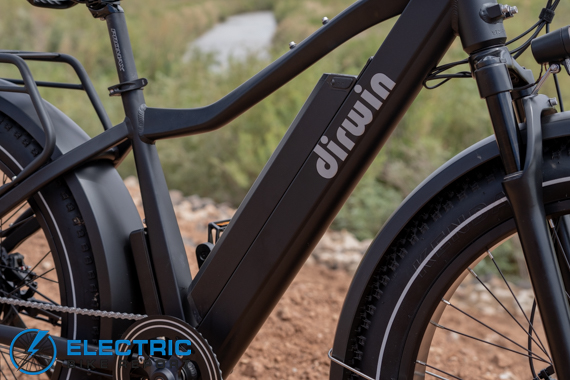
Semi-integrated battery pack.
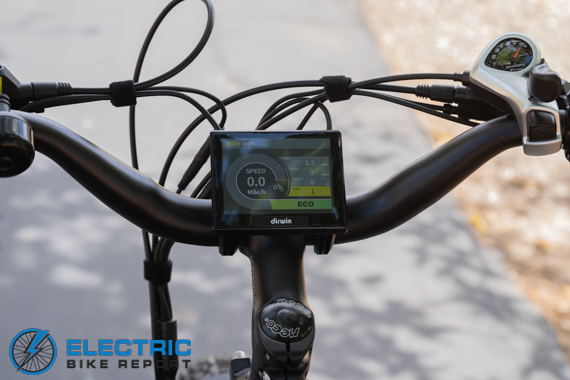
LCD color display.
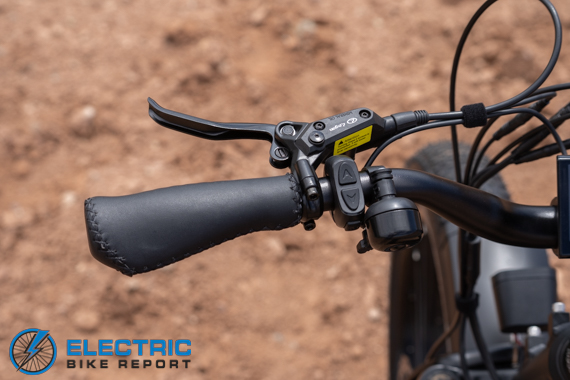
LCD display controller.
Dirwin Seeker Review: Components and Accessories
Dirwin stocked the Seeker with solid componentry, from the Logan hydraulic disc brakes to the Shimano Altus drivetrain the pieces that make up this bike do their job well. When the time comes, components like the Shimano Derailleur and the Kenda tires are easily replaceable too.
Brakes
One of the first things I noticed when I built the Seeker was the Logan hydraulic disc brakes. This wasn’t a brand I had previously heard of and I was very curious about how they would perform. These brakes are paired up with 180mm disc rotors front and rear.
When I was riding off-road and down steep hills I had enough power to modulate my speed to corner safely. The brakes bite quickly and also offer a decent amount of power when pulled hard.
We conducted a brake test where we measured the distance it took to stop from 20 mph. We did this test 5 total times, and took the average stopping distance. It took 17-feet 5-inches on average for the Seeker to stop which was a little farther than I was expecting.
I think this is mainly due to the weight of the bike as the tires were completely locked up and skidding during the test. Because the Seeker weighs over 70 lbs it did take a minute to come to a complete stop. I would deem these brakes safe, it’s just a heavier bike — something to keep in mind when slowing down and coming to a stop.
Frame
The Seeker’s frame is constructed of 6061 alloy and houses the semi-integrated battery within the downtube. The frame comes with a water bottle cage mount and mounting points for the rear rack. It also comes with mounts for the front basket available on Dirwin’s website.
Fork
The spring fork comes with a lockout and preload adjustment. This fork adds a lot of all-terrain capability to the Seeker as it softens the blows to the front end and keeps the front tire rolling over obstacles.
I used the lockout for most of my on-road riding and when I rode the Dirwin turned completely off. The all black uppers and lowers of this fork fit the dark theme of the Seeker quite well. I think the spring fork is a nice addition to the Seeker, it adds both comfort and performance.
Drivetrain / Shifting
The 7-speed Shimano Altus drivetrain comes with a 42T chainring and an over the bar thumb shifter. I think they nailed the gear range on this bike, I had a gear for maintaining speed on straight aways and I also had gears for climbing hills comfortably.
When the bike died on me during my range test I was able to pedal the Seeker back to the EBR headquarters thanks to the gear range on this bike, had it been harder I would have been walking.
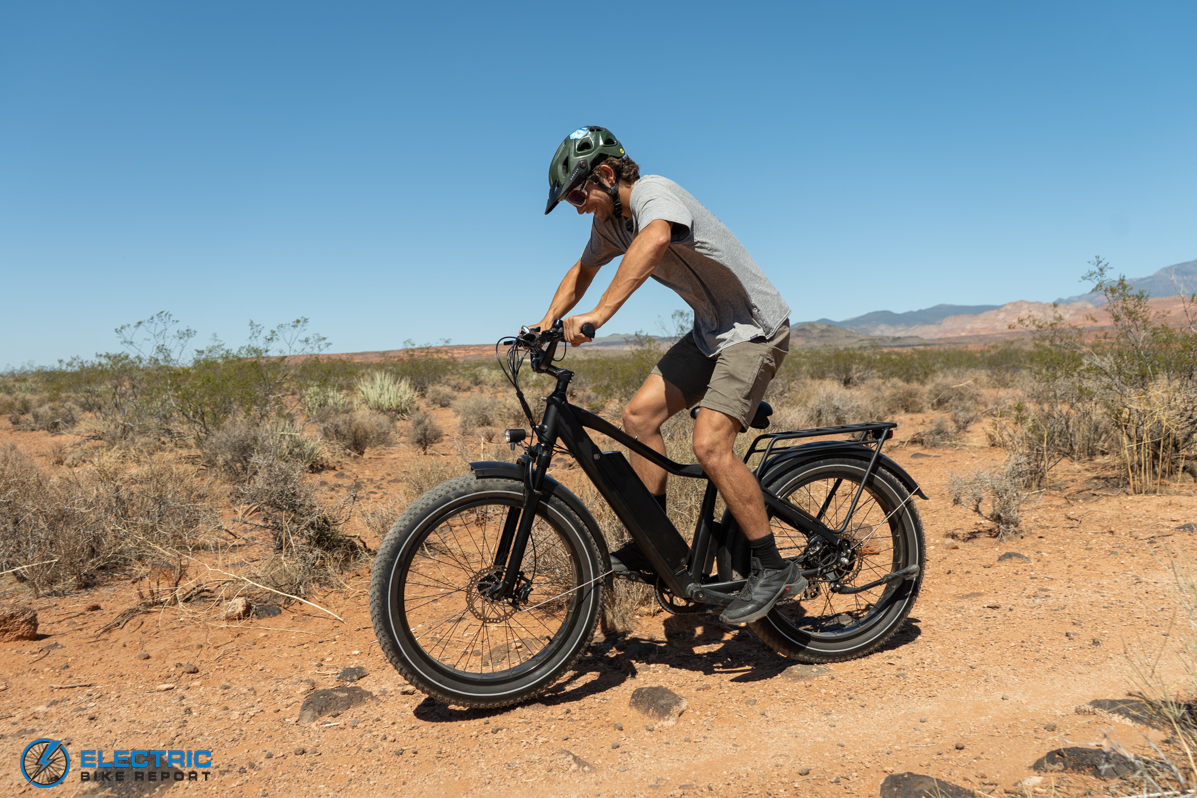
Riding over some rocky single track in St. George, Utah on the Seeker.
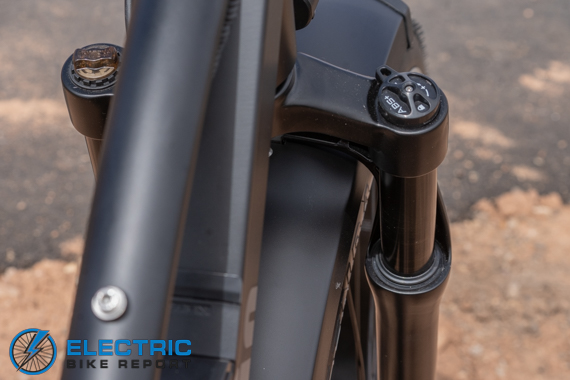
The Seeker’s fork comes with a lockout and preload adjustment.
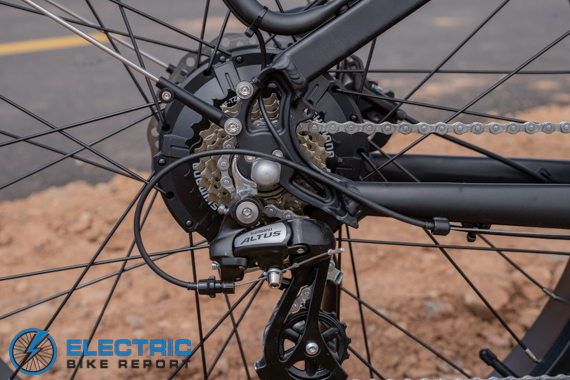
The Seeker uses a Shimano Altus 7-speed drivetrain.
Contact Points / Comfortability
The Seeker is a pretty comfortable bike, mainly due to its wide seat, ergonomic grips and high-rise handlebar. The suspension fork and 4-inch tires also help smooth out the ride. The Seeker has sporty geometry that still keeps the rider mostly upright. The positioning and contact points on this bike feel like a good median of performance and comfort.
The saddle, grips and handlebar are all easy to swap out if there is a different model or style you prefer, just keep in mind that one of the grips may have to be shortened for the throttle placement.
Tires
The Seeker comes with 26” x 4.0” puncture resistant fat tires. The tread pattern gave me lots of grip and really helped the bike maintain traction on off-road terrain. So far the tires are living up to their claims of being puncture resistant. Our team has put well over 100 miles on the Seeker and not once have we had to replace an inner tube. These tires also come with reflective sidewalls that improve visibility in low light conditions.
Extras / Accessories
Dirwin offers a decent amount of accessories on their website. Accessories such as the rear storage rack and full coverage fenders are included with the bike. Dirwin also offers replacement components on their website which is great to see, pretty much everything that comes on the Seeker is available for re-order via Dirwins website. I’d recommend picking up a couple of extra inner tubes at checkout.
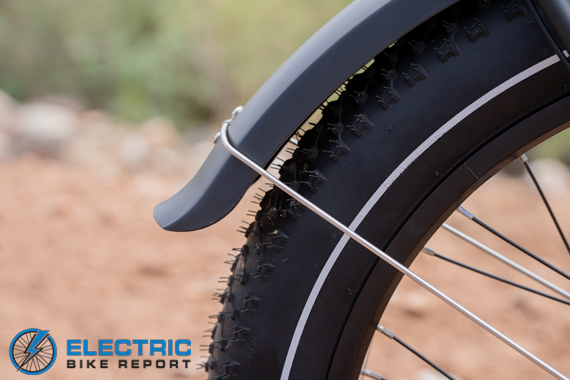
The Seeker comes with front and rear full coverage fenders.
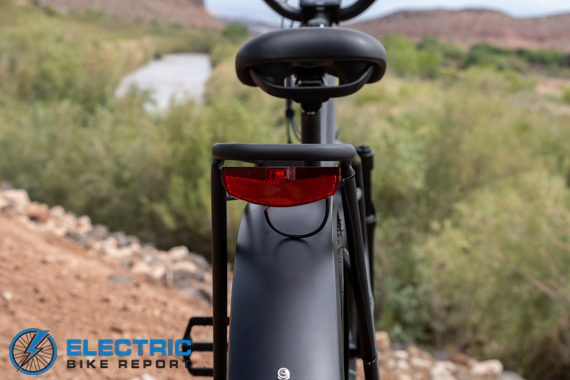
The rear storage rack and taillight on the Dirwn Seeker.
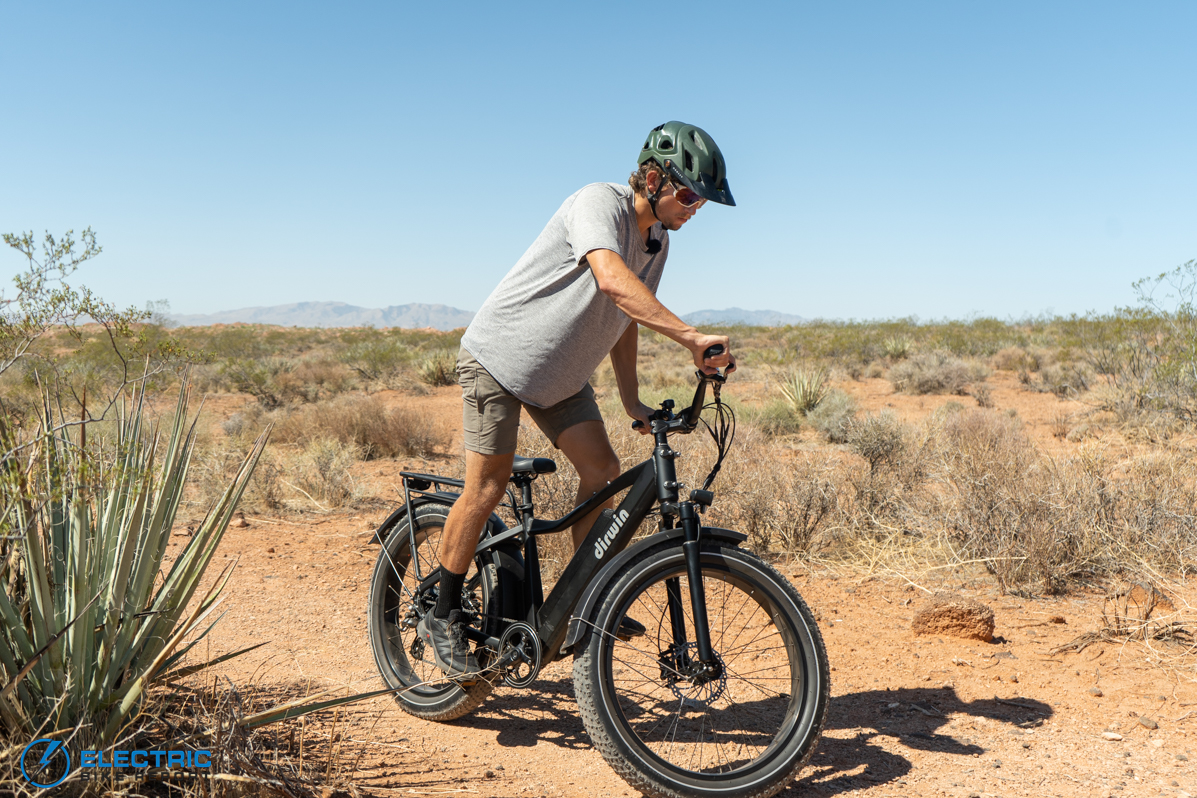
Our tester cornering the Seeker on a trail in St. George, Utah.
Dirwin Seeker Review: Summary / Where to Buy
*Dirwin is including a coupon code for Electric Bike Report’s audience. You can receive $60 off the Dirwin Seeker when you click the button below and use the code JUSTIN at checkout.

The Dirwin Seeker review was a fun one to conduct, the main reason being it showed us what a well rounded machine it truly is. While there are lots of other fat tire e-bikes on the market that are similarly spec’d and priced, not all of them match the refined feeling of the Seeker.
I found the 750W rear hub motor to really tie together the capabilities of this bike. The 80 Nm of torque this motor can produce sets it apart from some of the other 750W motors i’ve tested. It also seems to engage a little smoother and more predictable than most of them.
The 48V, 16Ah battery managed to hold onto a charge for quite a while when I conducted the maximum pedal assist range test. I rode at an average speed of 20.7 mph, which was just 3.3 mph off of the bike’s top speed of 24 mph. Considering I got 32 miles out of the battery while riding at this speed I think it’s safe to say battery range shouldn’t be an issue on the Dirwin Seeker.
The Seeker also had one of the more linear power curves we’ve seen. Each increased pedal assist level had a predictable amount of power increase, which added to the mentioned refined feeling of this bike. The pedal assist settings are viewable via the LCD Display which has a deep color way and all of the information you’ll need to see when riding.
With so many fat tire e-bikes flooding onto the market it can be hard to decide which one is right for you. After 108 miles on the Dirwin Seeker I can say that this is a great choice for those who value a smooth ride and want to be able to ride virtually anywhere.
This bike is equally capable on paved and gravel roads and will supply a long battery life regardless. Between the motor, battery, LCD display and overall ride experience it’s safe to say the Seeker is a step ahead of some of its competitors.
‘Happy Riding, make sure to let us know if you have any questions down in our comments section or if you think we left anything out in this review of the Dirwin Seeker.
Reader Interactions
![]()
Source link







